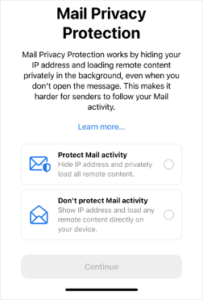In June, Apple announced iOS 15 email privacy changes that will radically change the email programs of all publishers.
According to Apple, Mail Privacy Protection “helps users prevent senders from knowing when [a person] opens an email, and masks their IP address so it can’t be linked to other online activity or used to determine their location.”
When iOS 15 rolls out in September, publishers will not be able to track who opened their emails on Apple Mail.

Apple won’t bury Mail Privacy Protection deep within the iOS settings. As they did with cross-app tracking permissions in iOS 14, Apple will automatically present the choice to “Protect Mail activity” to users the first time they open the
The vast majority of Apple Mail users will upgrade to iOS 15, and you should expect nearly everyone to “protect mail activity”. After all, why wouldn’t they?
Bottom line, what this means is that email open tracking will radically change starting in September.
How Does This Change Affect Publishers Specifically?
For most publishers, this change will affect 25-50% of your email subscriber base. Your email analytics will show you the specific percentage for your database.
Around 25-35% of B2B email subscribers use Apple Mail. For consumer publishers it can be 40-50% or more. This is in line with the May 2021 Litmus Email Client Market Share report.
Surprisingly, Apple’s change actually means that unique and total open rates will artificially go up, not down.
Apple won’t block the tracking pixels we use to see who opens an email and who doesn’t. Instead, they’ll be pre-loading all tracking pixels before a subscriber sees the email.
Let’s apply this to a practical example. Assume your average unique open rate is 25% and that 40% of your readers use Apple Mail. After iOS 15 launches in September, your unique open rate will artificially change from 25% to 55%.
Keep in mind that this privacy change will only affect actual Apple Mail users. It will NOT affect people who use Gmail, Outlook or another mail app on their iOS device. And many people will use a mail application like Gmail or Outlook on desktop but use Apple Mail on their mobile device.
Bottom line, iOS 15 Mail Privacy Protection represents a huge change that will affect the open rates of your email campaigns.
How to Adapt to the iOS 15 Email Privacy Changes
Here is what publishers must do to adapt to the iOS 15 email privacy change coming in September:
- Adjust Your Baseline Email Open Rate Expectations
Analyze your own email lists and determine how many people open your emails on Apple Mail. Do the calculations and estimate how this change will likely impact your unique and total open rates. Adjust your expectations and baseline KPIs accordingly.
- Educate Your Team and Clients
Ensure your editorial, production, audience development and sales staff are all aware of this change. Everyone on your team will be impacted and will need to adjust their expectations.
You must also educate your clients who purchase email advertising or sponsored emails from you. Show them how the change might impact your reports but assure them that your email efforts are still getting through to the right audience.
- Update Your KPI Reports and Dashboards
Email KPI reports and dashboards often have open rate performance benchmarks. Make sure that you’ve properly adjusted or at least annotated the changes.
You may also consider having a second version of your KPIs where you report only on non-Apple mail email recipients as those open rates will not be affected. This is only possible if your email provider actually makes that segmentation and reporting available.
On a positive note, email traffic reported by Google Analytics or other website analytic tools should not change as Apple is not blocking the tracking of clickthroughs … at least not yet.
- Change Your Email Engagement and Cleansing Process
Most publishers have implemented an automated or manual email list cleansing process. This is typically based on how long it has been since an email recipient has opened an email.
After the iOS email privacy change, subscribers on iOS devices will appear as if they always open your emails. This means you’ll be keeping subscribers on your list that are not actually engaged or opening your emails. This can eventually damage your sender reputation.
Publishers should temporarily turn off automated list cleansing processes at the end of August. Then, monitor your key engagement metrics after the launch of iOS 15. Make sure that you understand how the new privacy change impacts your metrics before re-enabling automated or manual list cleansing.
Change the way you measure engagement by focusing on clicks and website visits instead of opens. Some email providers are also adapting to give publishers the ability to have different engagement processes for Apple Mail subscribers versus other email clients.
- Modify Your Automations
As with engagement, you will also want to audit and modify any other automations you have in place that rely on email open tracking. The iOS change will report false positives, so you’ll need to adjust your automation workflows to account for that change.
For example, some publishers have lead nurturing programs and send reports back to advertisers about people who have opened their emails. The automations may trigger additional emails or other steps based on whether someone opens or not. Other publishers use welcome or other automations to help drive paid or controlled subscriptions.
- Design Your Emails to Encourage Clicks
Clicks will become the defining email KPI going forward. Take a close look at the design of your email newsletters and direct emails. Are they optimized to encourage clicks?
You’ll need to find the right balance between providing value within the email itself and encouraging people to click back to your site. In this regard, the iOS change is actually going to force publishers to make changes to their email newsletters that they probably should have made long ago.
- What About Ads Served into Email from Ad Servers?
Some publishers serve ads into email using a programmatic system like LiveIntent or their own ad server like Advertserve or Broadstreet. These ads are typically served into email using an image with parameters unique to the specific recipient and campaign.
Currently, these systems only count ad impressions when someone actually opens the email and sees the ad. However, with the upcoming change, every Apple Mail subscriber will count as an impression whether or not they actually open the email.
You will still be able to serve ads into Apple Mail. Actual clicks will be unaffected and should remain at the same levels. However, impressions served into email will be over-counted and this will also lead to a reduction in click-through rate (CTR).
Finally, not many niche publishers geotarget email ads, but if you do, geotargeting will become much less reliable after the iOS 15 email privacy change. Apple Mail will act much as the current Gmail app does with its image caching.
Life After the iOS 15 Email Privacy Change
This is not the death of email, but rather an evolution. Publishers, readers, advertisers and email systems providers will all adapt.
Yes, this change will be disruptive. But email remains a strong and viable platform for growing and engaging audiences … and for connecting your advertisers to a highly targeted audience.
Make the changes outlined above and your publication will successfully navigate the new email landscape.







